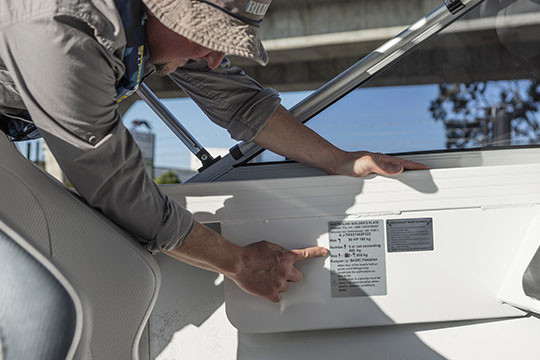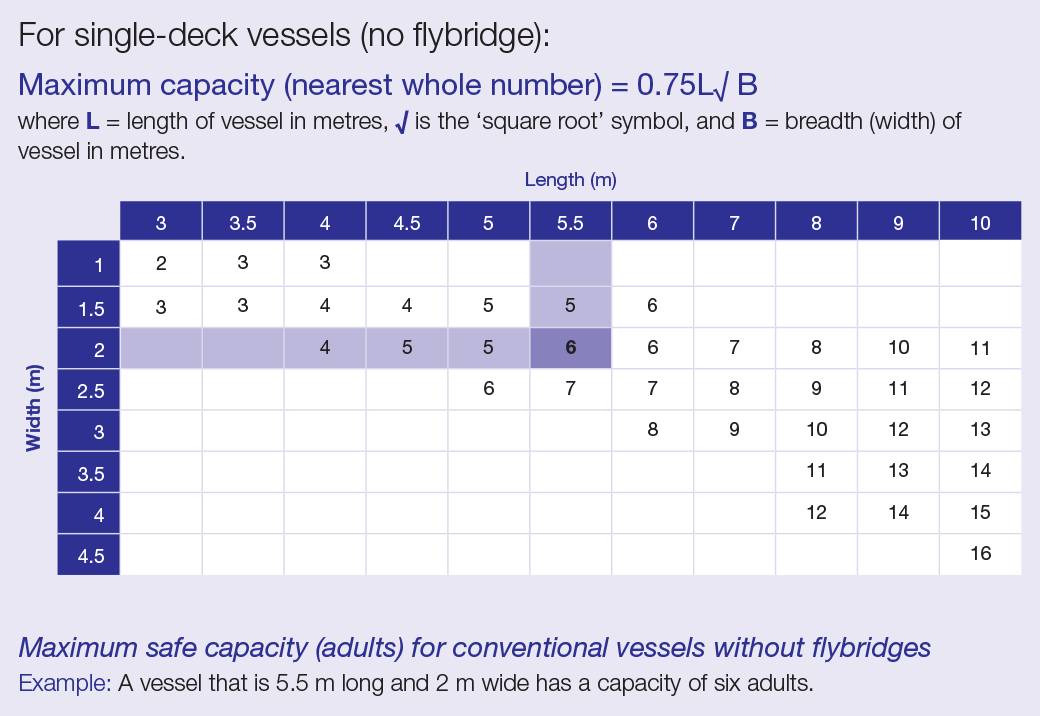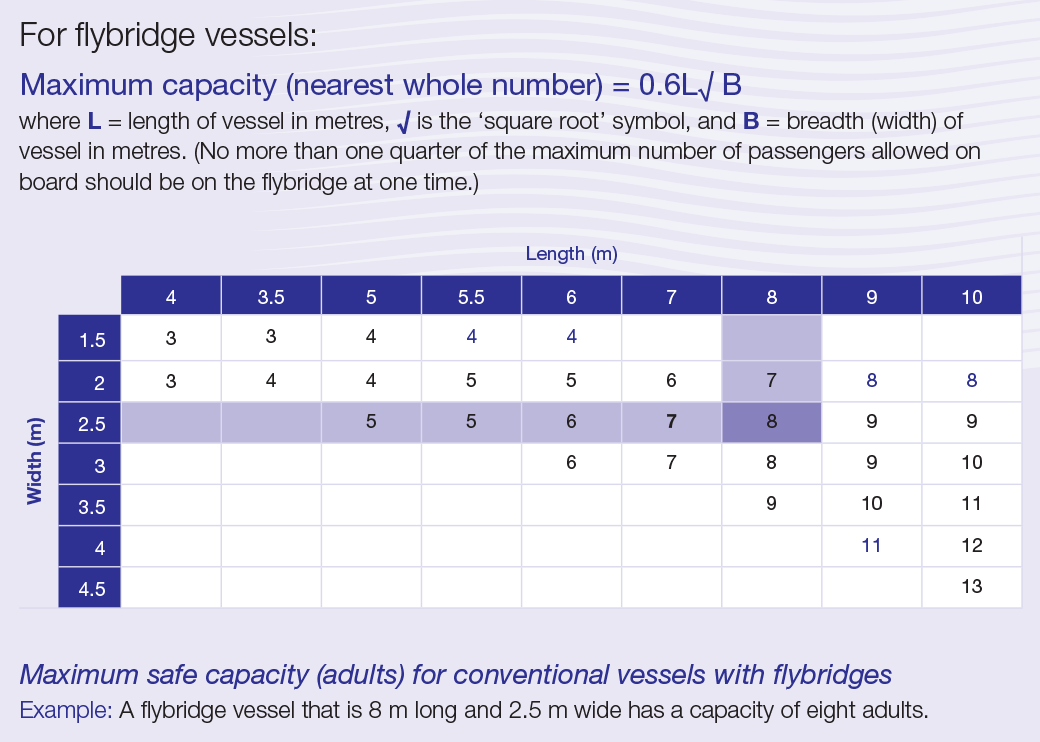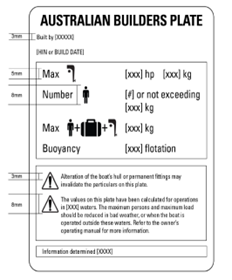Boat capacity - Check your Australian Builders Plate
You need to use common sense when judging how many people to carry on your boat. Overloaded boats are unstable and dangerous. Remember adverse weather conditions, open seas, carrying children all impact on your boat’s capacity.
Refer to the information on the Australian Builders Plate (ABP) National Standard in the drop down menu below or the manufacturer's compliance plate, if one is fitted to your boat, to determine the maximum number of adults a boat can legally carry. The ABP also provides information about the maximum horsepower (HP) a boat is allowed. Boats built after 4 February 2008 (unless exempt) are required to have an Australian Builders Plate fitted.
If your vessel does not have either a manufacturer's compliance plate or an ABP use the maximum capacity tables below. To use the tables, you need to know your boat's length and breadth in metres.
The maximum number of people you can carry safely in calm waters under ideal conditions, such as on the River Murray or other protected waters, is indicated where the length and breadth measurements for your boat intersect. It is based on an average weight of 75 kilograms per adult.

Check your ABP for the maximum number of people the boat can carry
Maximum capacity tables
Table 1: maximum people capacity
Conventional vessels without flybridge (conventional-type boats such as single hull open, half cabin or cabin boats not fitted with a flybridge).

Table 2: maximum people capacity
Conventional vessels with a flybridge.


Adverse weather and open seas
The number of people should be reduced by about one third when boating in adverse weather conditions or on the open sea.
Carrying children
Children under 12 years old can be counted as half an adult when adding up the number of people on board. For example, a boat with a capacity of four adults could safely carry three adults and two children under the age of 12. Children up to twelve months of age do not need to be included when determining capacity.
Boats over 10 metres in length
For boats over 10 metres in length, use the appropriate formula below to calculate the number of adults you can safely carry in calm water conditions. For single-deck boats (no flybridge) the formula is:
- maximum capacity (adults) = 0.75L√B (nearest whole number)
where L = length of boat in metres and B = breadth of boat in metres.
For boats fitted with flybridge the formula is:
- maximum capacity (adults) = 0.6L√B (nearest whole number)
where L = length of boat in metres and B = breadth of boat in metres.
Flybridge boats
For flybridge boats, no more than one-quarter of the maximum number of passengers allowed on board should be on the flybridge at any one time.
Australian Builders Plate National Standard
 The Australian Builders Plate provides safety information on recreational boats built after 4 February 2008 (unless exempt). There is a national requirement to have one.
The Australian Builders Plate provides safety information on recreational boats built after 4 February 2008 (unless exempt). There is a national requirement to have one.
Get a copy of the 5th edition National Standard for the Australian Builders Plate for Recreational Boats (the Standard).
The standard aims to improve clarity and ease of use, and to deliver better safety guidance for Australian boaters.
Major changes in the new standard include:
- The person capacity must now be displayed in compliance with the specified standard. Previously it was recommended by the boat builder.
- Flotation must be fitted in accordance with the standard requirements. Most boat builders must choose a standard that allows basic flotation (for example, AS1799 – 2009) if they wish to fit that type of flotation to a boat. Previous standards allowed boat builders to fit either basic or level flotation, regardless of the flotation type specified by the standard.
- Person capacity will now be shown as a number of persons on board or not exceeding a certain weight in kg.
- Auxiliary outboard mass and associated equipment must be considered as part of the Australian Builders Plate generic ‘maximum load’. The previous standard required boat builders to only consider this.
- When a HIN is already affixed to a boat, the HIN must also be displayed on the Australian Builders Plate. When a HIN is not present a build date can still be used.
- The standard requires all Australian Builders Plates to include a warning statement regarding the decrease of loading masses in adverse conditions. This was previously optional.
- All boats with a flybridge must include a warning statement on their Australian Building Plate stating the maximum passenger capacity of the flybridge and to fit an additional Australian Builders Plate adjacent to the flybridge steering position.
Boatbuilders must apply the new standard.
In South Australia, it is an offence to sell a recreational boat built on or after 4 February 2008 without an Australian Builders Plate fitted, unless the vessel is a type exempted from the ABP requirements.
Always check the plate before purchasing a boat, as it is designed to give potential buyers the information to assess whether the boat is suitable for their needs.
The plate includes the following details:
- the maximum weight and power rating of the engine
- how many people can be carried not exceeding a certain weight
- the maximum load that the boat can carry - including people and equipment.
Boats up to six metres in length will also include a buoyancy statement.


